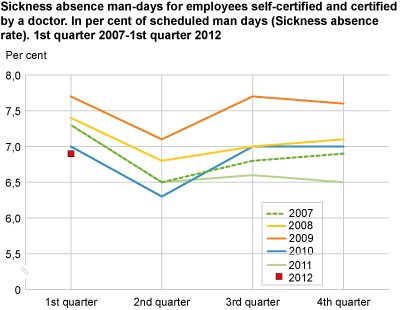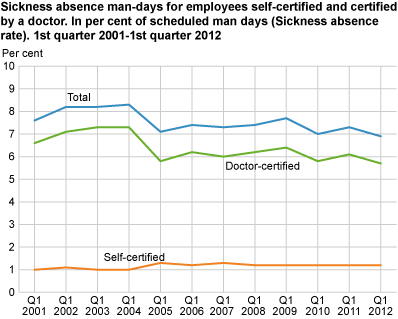Content
Published:
This is an archived release.
Decrease in sickness absence
Sickness absence decreased from 7.3 to 6.9 per cent from the first quarter of 2011 to the first quarter of 2012; a decrease of 5.6 per cent.
Doctor-certified sickness absence decreased from 6.1 to 5.7 per cent - a fall of 7.3 per cent. Self-certified sickness absence had a small increase of 3.2 per cent, but rounding off gives the same level as last year; 1.2 per cent.
Sickness absence in the first quarter of 2011 was 8.7 per cent lower than in the first quarter of 2001, which was the first year of implementation of the agreement on an inclusive labour market.
Strongest decrease for men
Sickness absence for men decreased from 5.8 to 5.4 per cent. The absence for women decreased from 9.3 to 8.9 per cent; a fall of 6.9 and 4.3 per cent respectively.
Decrease in the construction industry
Amongst the major industries, the construction and accommodation and food service industries had the strongest decreases, of 11.8 and 9.9 per cent respectively.
Public administration and defence was the only industry with an increase in sickness absence, of 1.9 per cent. The level of sickness absence in this industry; 6.4 per cent, is still below the average for all industries of 6.9 per cent.
Strongest decrease in private sectors
Sickness absence dropped in all sectors. The private sector had the strongest decrease by 7.4 per cent. In local government, the absence fell by 2.6 per cent, while the absence in central government (including health enterprises) dropped by 1.2 per cent.
The sickness absence level in the 1st quarter of 2012 was lowest in the private sector with 6.3 per cent, while central and local government had an absence of 7 and 9 per cent respectively.
Decrease in all age groups
The doctor-certified absence fell in all age groups below 66 years. The strongest reductions were within the age groups 25-29 and 45-49 years, by 9.5 and 9 per cent respectively.
For men, the strongest declines were among the age groups 25-29 and 35-39 years, by 11.5 and 11.4 per cent respectively. For women, the strongest reductions were in the age groups 20-24 and 25-29 years, by 8.7 and 7.9 per cent respectively.
These results are based on data on sickness absence certified by a doctor, as the survey on self-certified absence does not contain data on sickness absence by age.
Sickness absence by new industry classification dating back to 2000A new industry classification was introduced as from the figures published for the first quarter of 2009. These will give a break in the time series for the figures by industry. Statistics Norway has calculated figures according to the new industry classification dating back to 2000. We refer to tables 3 and 33 under “ More tables ”.
Sickness absence according to the Labour Force Survey dating back to 1972The sickness absence statistics give figures dating back to the second quarter of 2000. For longer time series, we need to use other data sources, for instance the Labour Force Survey (LFS). Tables for sickness absence according to the LFS dating back to 1972 (total figures) and 1979 (men/women) are now available in StatBank . |
Technical informationRates of change The sickness absence rates are presented using one decimal point. More decimal points are used when calculating the rates of change in order to get more accurate figures. These will therefore differ slightly from the rates of change produced when using the published rounded figures.
The statistics do not cover self-employed persons. |
Tables
Sickness absence man-days for employees in per cent of scheduled man-days. Seasonal- and influenza adjusted
- Table 35 Sickness absence man-days for employees aged 16-69 in per cent of scheduled man-days, by type of certification. Seasonal- and influenza adjusted. Quarterly figures and change in per cent from previous quarter
- Table 36 Sickness absence man-days for employees aged 16-69 in per cent of scheduled man-days, by sex and type of certification. Seasonal- and influenza adjusted. Quarterly figures
- Table 37 Sickness absence man-days for employees aged 16-69 in per cent of scheduled man-days, by sex and type of certification. Seasonal- and influenza adjusted. Change in per cent from previous quarter
Sickness absence man-days for employees self-certified and certified by a doctor. In per cent of scheduled man-days (Sickness absence rate). Quarterly figures
- Table 1 Sickness absence man-days for employees self-certified and certified by a doctor. In per cent of scheduled man-days (Sickness absence rate). Quarterly figures. 2000-2012
- Table 2 Sickness absence man-days for employees self-certified and certified by a doctor, by sex. In per cent of scheduled man-days (Sickness absence rate). Quarterly figures. 2000-2012
- Table 28 Sickness absence by type of absence(self-certified or doctor-certified) and duration within the quarter
Contact
-
Arbeidsmarked og lønn
E-mail: arbeidsmarked@ssb.no
-
Unn H. Høydahl
E-mail: unnh.hoydahl@ssb.no
tel.: (+47) 40 90 23 77


